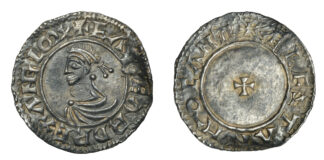Extremely Rare Roman Solidus Discovered by Metal Detectorist
A long time Metal Detectorist has just found his best ever coin – a Roman gold Solidus of the Emperor Constantine I in almost perfect condition. Dix Noonan Webb will offer the coin in a sale of Ancient Coins on Tuesday, September 17, 2019 at 10am at their auction rooms in central Mayfair – 16 Bolton St, London, W1J 8BQ. It is estimated to fetch £10,000-12,000.

It was his first time searching the field after gaining permission from the farmer which is at Wanstrow in Somerset close to a Roman road once used for transporting mined lead ore. Using a second hand metal detector, a Nokta Fors Core which is manufactured in Turkey, he saw that the field had a curious unnatural shape to it. Detecting carefully in this spot he found a Roman brooch and several pieces of lead ore. Then at a depth of nearly a foot he discovered the gold coin. The find was then recorded on the portable antiquities database by the local finds liaison officer who realised it was the first one of this type to be found in Britain. After having the coin returned, the finder and the land-owner agreed to auction it with DNW.
As DNW’s Antiquities specialist, Nigel Mills, explains: “The coin is a magnificent example of a gold Solidus minted in 313-5 at Trier, the capital of Gaul. This was a new denomination introduced by Constantine in 310. On the obverse is a laureate portrait of the emperor, which had been the tradition for over 300 years but was about to change with a new headband called a diadem in 324. For the first time there is a break in the legend above the Emperor’s head symbolising a clear path to heaven from Constantine. He also stopped using the old Roman pagan gods on the reverses of his coins.”
He continues: “On the reverse is an extremely rare portrayal of Constantine riding his horse in battle holding a spear and shield with two fallen enemy soldiers below. It commemorates his great victory over Maxentius at Milvian bridge outside Rome on 28th October 312. This is where Constantine adopted a new military standard of the Chi-Rho or Christogram – these are the first two letters in Greek for Christ “XP” hence the importance of this victory for Constantine and Christianity. The British Museum has a similar example in their collection but with different spacing in the reverse legend. No Solidus of Constantine with this reverse having sold for many years.”
Flavius Valerius Constantine was born AD 272. He accompanied his father the western Emperor Constantius I to Britain in a hard fought campaign against the Picts in northern Britain. At Eboracum (York) on the 25th July AD 306 Constantius died from ill health and the soldiers proclaimed Constantine as their leader. He at first took the junior rank of Caesar to avoid conflict with the other rulers of the Roman tetrarchy, and he accepted the joint title of Augustus in 307, becoming sole ruler in 324 after deposing the eastern Roman emperor Licinius.
It was after the decisive victory over the usurper Maxentius at Milvian bridge that Constantine became supportive of the Christian religion with his edict of Milan in 313. Towards the end of his reign Constantine founded the new capital of Constantinople in 330. He was baptised on his deathbed on May 21st 337.

Russian Coins
On the same day, at 2pm, Dix Noonan Webb will be holding their first auction devoted to Russian Coins and Historical Medals. The most important part of the sale is an old collection of Russian historical medals, mostly formed in the 1960s and 1970s. Three highlights from this collection include an extremely fine and very rare silver medal from the reign of Tsar Peter the Great (1682-1725), dating from 1704 and commemorating the Capture of Narva, by I. Konstantinov. The medal, estimated at £3,000-4,000, portrays a uniformed laureate bust of Peter I on one side and a view of the bombardment of Narva on the other.

An extremely fine and very rare silver medal depicting the Coronation of Catherine the Great (1762-96) from 1762, by T. Ivanov and G.C. Waechter, showing a crowned bust of the Empress on one side and Russia and Faith standing at an altar, with Providence in the cloud above holding a crown and sceptre, on the other, is expected to fetch £3,000-£4,000.

Also of note is an extremely fine and extremely rare silver medal of Catherine the Great (1762-96), dating from 1771 by G.C. and J.G. Waechter. On one side of the medal is a portrait of the Empress, who was the country’s longest-ruling female leader, while the other side shows Count Grigory Grigorievich Orlov on horseback with a view of Moscow in the background. Count Orlov led the coup which overthrew Catherine’s husband Peter III and installed Catherine as empress. This medal is estimated at £9,000-£12,000.
The sale also contains nearly two hundred lots of coins, including a good selection of the medieval coins commonly known as ‘wire money’, and historical medals from other properties.
Tim Wilkes, Specialist in Charge, Coin Department, Dix Noonan Webb, commented: “We are very pleased to be holding our first auction devoted to Russian Coins and Medals dating from the 14th century to the 21st century. The coins and medals depict many of the significant figures and key historic moments in Russian history.”
On the DNW website you can find all information on the auction of ancient coins.
Also available is the full catalogue of the auction of Russian coins.
For further information go to the hompage of the auction house’s website.
ADDENDUM: The solidus was sold for £20,608 (including 24% buyer’s premium and VAT). It was bought by Hadrien Rambach, a European Dealer on behalf of a collector.




